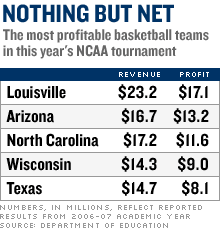 |
Commentary: | |
| SportsBiz | ||
Big dollars score in NCAA tourney
Upsets are fun to see but the fact is that small-budget Cinderellas have little chance against deep-pocketed schools in March Madness.


 |
| Duke got a scare from upstart Belmont in this year's NCAA tournament, but the big dollar teams typically win out in the end. |
NEW YORK (CNNMoney.com) -- This might seem like the year of the evil stepsisters in the NCAA tournament. All four No. 1 seeds got a spot in the Final Four.
But the truth is that even if Cindrella school Davidson had beat Kansas last Sunday night, the small-town North Carolina school with less than 1,700 students never really stood a chance where it really matters in college sports - in the dollars and cents of its sports program.
According to figures filed with the Department of Education by each school, Davidson's men's basketball program had revenue last year of $1.3 million, and a profit of about $176,000. Compare that to Kansas, which had 10 times the revenue - $13.2 million, and a profit of $7 million.
That was enough to make the Jayhawks the eighth richest program in terms of revenue, while the Davidson Wildcats were the 14th poorest out of the 65 teams in the tourney.
That's not to say that dollars determine who wins the games. Davidson's success knocking off Georgetown, Gonzaga and Wisconsin is proof of that. But it does show just how much of an uphill battle the Davids of the tournaments have against the Goliaths.
Before I get a lot of hate mail from readers that I'm dismissing the small-time schools too easily, let me say my rooting interest in this year's tournament was Mount St. Mary's, the victor in the play-in game and first round fodder for North Carolina. My sister-in-law, Mary Kate Birge, is a nun and a professor at Mount St. Mary's.
Basketball dollars at the Mount, as it is known to students and faculty, made Davidson look like a deep pocket powerhouse. It had revenue of $876,744 and merely broke even.
By comparison, North Carolina's men's basketball program had revenue of $17.2 million during the 2006-07 school year, second only to the University of Louisville's $23.2 million among the 65 in this year's tournament. North Carolina's profit of $11.6 million trails only Louisville's and Arizona's.
But every year people watch mismatches in the hopes they'll be surprised. A 16 seed is never beaten a top seed but there have been a handful of 15 seeds who knocked off 2 seeds in the first round. And tiny Belmont (revenue of $1.2 million) almost did so against mighty Duke (revenue of $13.4 million) in the tournament's opening night.
Duke and North Carolina, besides sharing a one of the great rivalries in sports, also share a built-in financial advantage.
The poor schools will stay poor despite the $545 million per year that CBS (CBS, Fortune 500) is paying to broadcast the tournament during the life of its current 11-year deal. The television and ticket money is mostly paid to the conferences, based upon the games in the tournament played by each conference over the the most recent six years. Those pools of money are then split between the teams in the conferences.
So even though Davidson won three games in the tournament this year, and Duke managed only to squeak by Belmont before losing to West Virginia, Davidson will get a smaller check from the Southern Conference than Duke will get from the ACC.
In addition, the regular-season ticket sales and television money for the powerhouses from the major conferences dwarf what's available for the so-called mid-major schools.
There are a few mid-major schools in the tournament with large revenue streams and good prospects, like Final Four participant Memphis and Xavier, which made it to the Elite Eight, but they're the exception, not the rule.
The 34 schools from the major conferences in this year's tournament have average revenue of $9.4 million, and an average profit of $4.4 million, giving them a 47% profit margin that any NBA team would give up a decade worth of No. 1 draft picks to achieve.
The remaining schools from the so-called "mid-major" conferences average just under $2 million in sales and an an average profit of $360,814, giving them a profit margin of only 18%. In fact, eight of those 31 schools reported losses from their basketball programs.
So it shouldn't be a surprise that the Final Four comes down to the big money, top-seeded teams playing each other, as it does almost every year.
And while everyone says they love the David vs Goliath battles of the NCAA, the ratings for the Final Four show that what America truly loves is when big schools make it to the finals.
More people watched the final three games of the tournament last year, which included Florida, Ohio State, Georgetown and UCLA, than watched the four-game sweep of small market Cleveland by even smaller market San Antonio in last year's NBA Finals.
The Mount and Belmont are already distant memories to most viewers who will tune in Saturday and Monday for the final game. And that will be just fine for CBS, most basketball fans and the teams that profit from the tournament. ![]()

